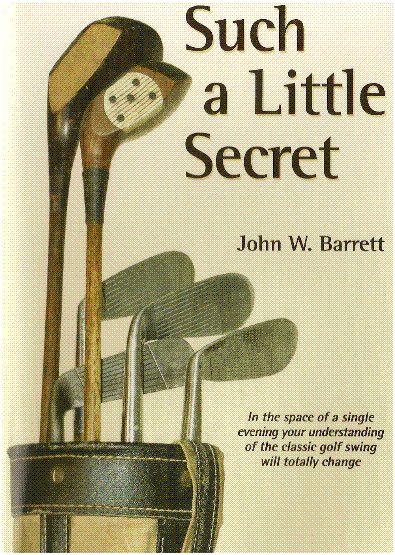 [i]
[i]
‘Such a Little Secret’ /i is indeed a most charming golf book, written by John Wilson Barrett, an English technical author, lover of golf and golf literature, who has been playing golf for over 50 years. The cover clearly sets the tone for the contents. Kind of up Lag’s sleeves as Barrett also feels that not much has been added to golf instruction during the last 50 years. His favorite golf authors – Harvey Pennick, Tommy Armour, Ben Hogan and Bobby Jones.
I am not familiar with the various modules but from what is posted on the public forum it appears to me that there is a lot in ‘Such a little Secret’ rather close to Lag’s ideas. The book’s cover is very indicative. Also the contents, written in witty English prose, with virtually no illustrations, is reminiscent of the past.
41-43
[i]“…the hitting stroke then returns the clubhead along a entirely different path. Down and around from the player to reappear as it gets to be laterally to the front at about the level of his right knee, arriving at the ball on a shallow angle and from inside the ball-to-target line…”
“When the clubhead is swung from the ball to the top, 60 percent of the total length of that path is laterally to the front of the player. The other 40 percent is laterally the the rear of the player. When the clubhead returns from the top to the ball, however, 70 percent of the total length of that path is laterally to the rear of the player. The other 30 percent is laterally to the front of the player. Put another way, the clubhead is behind the player for just 40 percent of the length of his back swing, but must be held behind him for 70 percent of the length of his hitting stroke.”
“What comes next is a somewhat less exciting, but absolutely necessary examination of the facets of the swing that makes it possible for a player to hold his clubhead laterally behind him for over two-thirds of the distance it must travel to the ball.”
“…not one moment before the transfer of weight has both powered and lowered an unchanged top assembly to its correct position above the right hip, do the arms or hands turn on any power of their own.”
"…it will not be lost on him that the discrepancy between the clubhead returning correctly to the front at the level of his right knee, and the clubhead returning incorrectly to the front at the level of his neck (or higher) has been as much as three or four feet.”[/i]
80-81
[i]"…Those who swing their clubhead to their front with a three-feet-discrepancy between the incorrect and the correct position will have the higher handicaps. Handicaps reduce in direct ratio to that discrepancy. When the discrepancy is zero, behold, the single figure golfer whose handicap then depends solely upon practice, fine-tuning, and his ability to hole puts."
“The bringing up of the clubhead into powerful release rests upon bringing the top assembly to its crucial position at the right hip.”
"It is the expert’s primary coordinate, producing both length and repeatability, the fulcrum from which he releases the clubhead from way behind him and higher than his head to explode through the ball with such speed and power that further coordinates from fulcrum to follow-through can only be subliminal.”[/i]
The transition being only a short fleeting moment in time is often overlooked. Yet it is frequently the cross road leading to either success or failure.
136-137
[i]“…from the top. As it is forced to move the assembly remains virtually unchanged, particularly in respect to the fully cocked wrists and right elbow. The assembly offers no resistance and supplies no power whatsoever to the move it must make. However, the direction in which it first moves is of critical importance."
“Assuming that the backswing has been completed to the best of the player’s ability, the direction in which the hands must be guided is exactly that in which the end of the rubber grip is pointing when at the very top of the backswing. There should be no conscious effort, only guidance in the direction indicated by the butt end of the grip.”
“” …the first move of the hands should be directed, not powered, exactly in the direction in which the end of the grip is pointing." [/i]
There are golf instructions with admonition for a ‘vertical drop’, to ‘get into the slot’, swinging down to the trail foot, or compressing the trail side as the first move. Dante’s ‘Four Magical Moves’ also comes close, but I can’t remember having seen golf instruction which such clear emphasis on a very pronounced ‘vertical’ motion as the first move and as a consequence a very shallow inside attack trajectory onto the ball.
I am delighted to see a golf instruction book clearly mentioning the notion that the back swing is primarily a matter of creating sufficient space and time for a proper down swing sequence, and hence not coiling for power or any like wise notion. This notion of gathering power in the back swing to be released in the down/forward sing is still omnipresent in golf instruction and has really no justification.
mandrin